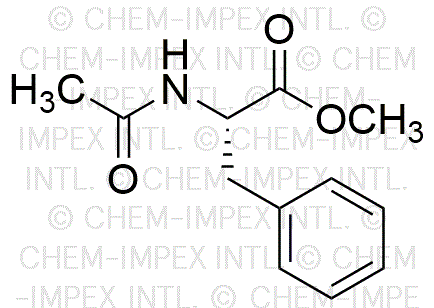Acetyl-D-phenylalanine methyl ester is widely utilized in research focused on:
- Peptide Synthesis: This compound serves as a building block in the synthesis of peptides, particularly in the development of pharmaceuticals that target specific biological pathways.
- Drug Development: It is used in the formulation of new drugs, especially in the field of neuropharmacology, where modifications can enhance the efficacy of therapeutic agents.
- Biochemical Research: Researchers employ this compound to study protein interactions and enzyme activities, providing insights into metabolic processes and disease mechanisms.
- Cosmetic Formulations: The compound is incorporated into skincare products for its potential anti-aging properties, helping to improve skin texture and elasticity.
- Food Industry: It is explored as a flavoring agent or additive, enhancing the sensory qualities of food products while ensuring safety and compliance with regulations.
General Information
Properties
Safety and Regulations
Applications
Acetyl-D-phenylalanine methyl ester is widely utilized in research focused on:
- Peptide Synthesis: This compound serves as a building block in the synthesis of peptides, particularly in the development of pharmaceuticals that target specific biological pathways.
- Drug Development: It is used in the formulation of new drugs, especially in the field of neuropharmacology, where modifications can enhance the efficacy of therapeutic agents.
- Biochemical Research: Researchers employ this compound to study protein interactions and enzyme activities, providing insights into metabolic processes and disease mechanisms.
- Cosmetic Formulations: The compound is incorporated into skincare products for its potential anti-aging properties, helping to improve skin texture and elasticity.
- Food Industry: It is explored as a flavoring agent or additive, enhancing the sensory qualities of food products while ensuring safety and compliance with regulations.
Documents
Safety Data Sheets (SDS)
The SDS provides comprehensive safety information on handling, storage, and disposal of the product.
Product Specification (PS)
The PS provides a comprehensive breakdown of the product’s properties, including chemical composition, physical state, purity, and storage requirements. It also details acceptable quality ranges and the product's intended applications.
Certificates of Analysis (COA)
Search for Certificates of Analysis (COA) by entering the products Lot Number. Lot and Batch Numbers can be found on a product’s label following the words ‘Lot’ or ‘Batch’.
*Catalog Number
*Lot Number
Certificates Of Origin (COO)
This COO confirms the country where the product was manufactured, and also details the materials and components used in it and whether it is derived from natural, synthetic, or other specific sources. This certificate may be required for customs, trade, and regulatory compliance.
*Catalog Number
*Lot Number
Safety Data Sheets (SDS)
The SDS provides comprehensive safety information on handling, storage, and disposal of the product.
DownloadProduct Specification (PS)
The PS provides a comprehensive breakdown of the product’s properties, including chemical composition, physical state, purity, and storage requirements. It also details acceptable quality ranges and the product's intended applications.
DownloadCertificates of Analysis (COA)
Search for Certificates of Analysis (COA) by entering the products Lot Number. Lot and Batch Numbers can be found on a product’s label following the words ‘Lot’ or ‘Batch’.
*Catalog Number
*Lot Number
Certificates Of Origin (COO)
This COO confirms the country where the product was manufactured, and also details the materials and components used in it and whether it is derived from natural, synthetic, or other specific sources. This certificate may be required for customs, trade, and regulatory compliance.


